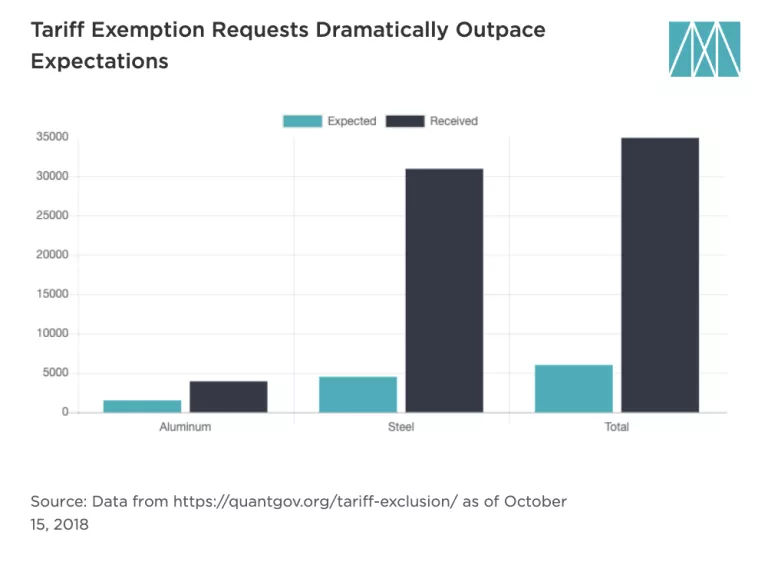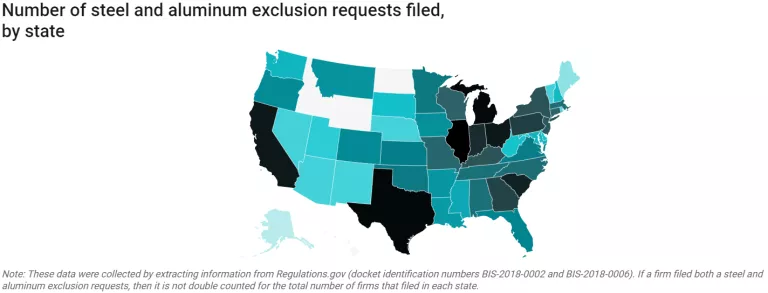- | International Freedom and Trade International Freedom and Trade
- | Expert Commentary Expert Commentary
- |
Tariff Exemption Requests Reveal Flood of Affected Firms
Have tariffs on foreign aluminum and steel been “no big deal,” in the words of Commerce Secretary Wilbur Ross? Or have they thrown an expensive monkey wrench into the economic mechanics of major US industries, as critics predicted?
According to new data compiled by Mercatus scholar Christine McDaniel and Danielle Parks, these trade policies appear to have been far more destructive to domestic industry than the administration anticipated.
The data shed light on the number of exemption requests that the Trump administration has received for its tariffs on steel and aluminum. Businesses are able to petition the Bureau of Industry and Security (BIS) and the Commerce Department for an exemption from individual trade duties if they meet certain criteria.
This is a public process that allows comment from other groups. Accordingly, other businesses or interest groups may object to a particular exclusion request and submit their counter-argument as to why the BIS and Commerce Department shouldn’t grant the request. Officials will then review the request (and any objections) to make a determination, which will be published on regulation.gov. If a request is denied, it may be petitioned through a subsequent exclusion request.
The exclusion request process, authorized under Section 232 of the Trade Expansion Act of 1962, opened to American businesses in March to ameliorate the presumably short-term negative economic effects of the steel and aluminum tariffs.
According to the Commerce Department website, exemptions are granted if “there is no domestic availability and there are no overriding national security concerns with regard to the specific product.” This means that businesses that rely on special components that cannot be reasonably procured domestically—like specialty steel—are eligible to petition for an exemption, provided that their sources are not deemed problematic for national security.
As McDaniel has pointed out, the administration did not expect the exemption option to be quite as popular as it is. Originally, officials estimated in its interim final rule on the process that they would receive some 6,000 total exclusion requests, broken down into 4,500 requests for steel relief and 1,500 requests for aluminum relief.

All of the data can be downloaded on the Mercatus Center’s QuantGov platform, which provides tools and data for the public to analyze policy-relevant issues like the ongoing tariff dispute. McDaniel and Parks also created handy graphics that break down the data by state and congressional district.

One takeaway of their dataset is the simple observation that American officials majorly underestimated the extent of the potential economic damage of their trade policies. As McDaniels notes at The Hill, it should come as no surprise that imposing taxes on critical raw materials like steel and aluminum would have dramatic effects on American manufacturers. What perhaps is surprising is that trade officials would not intuit this reality.
But there is a secondary story here as well, and that is the perils of introducing human subjectivity into major trade decisions.
Every one of those tens of thousands of exclusion petitions and counter-petitions is ultimately decided upon by a human being. The decision that any person reaches will depend on his or her sympathies, biases, and even mood upon reviewing the paperwork. And in the negative extreme of this arrangement, decision-makers can have self-interested or corrupt reasons for issuing their final verdicts.
Tariff exclusion requests are therefore an especially bad sign. Not only does it place American manufacturers in the undesirable position of having to work against their own government’s policies, it also introduces a potential new layer of government-granted privilege into the American economy.
First, certain industries are favored over domestic consumers and the downstream industries that rely on tariffed goods by design. So all but the unaffected few are worse off under trade barriers from the start.
But even within the iron curtain of protectionism, there is potential for privilege. Well-connected or well-lawyered firms may be better positioned to know who to contact and how to fill out their forms to get the greatest chance of an approved request. Alternatively, they may be better able to successfully object to the petition of a competitor. Smaller and less-savvy firms, who may actually be more exposed to the ravages of tariffs, will still bear the full burden of the tariff.
Indeed, a small handful of the firms in the dataset are responsible for a good number of the total exclusion requests.
For these firms, tariff exemptions may be a critical lifeline to keep their operations going in tough trading times. And it is good that businesses have an option to seek relief if needed. But we should keep in mind that this process is itself an unevenly distributed privilege, and the outcomes rely on fallible human judgment.